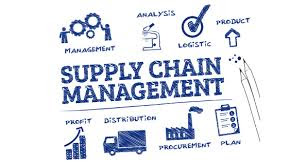CHAPTER 10
EXTENDING THE ORGANIZATION – SUPPLY CHAIN MANAGEMENT
SUPPLY CHAIN MANAGEMENT
*The average company spends nearly half of every dollar that it earns on production
*In the past, companies focused primarily on manufacturing and quality improvement to influence their supply chains
*In the past, companies focused primarily on manufacturing and quality improvement to influence their supply chains
BASIC OF SUPPLY CHAIN
The supply chain has three main links:
1. Material flow from suppliers and their “upstream” suppliers al all levels
2. Transformation of materials into semi finished and finished products through the organization’s own production process
3. Distribution of products to customers and their "downstream" customer at all levels.
1. Material flow from suppliers and their “upstream” suppliers al all levels
2. Transformation of materials into semi finished and finished products through the organization’s own production process
3. Distribution of products to customers and their "downstream" customer at all levels.
INFORMATION TECHNOLOGIES ROLE IN THE SUPPLY CHAIN
Information technology’s primary role in Supply Chain Management is creating the integrations or tight process and information linkages between functions within firm
FACTORS DRIVING SCM
1. Visibility
SUPPLY CHAIN VISIBILITY
Is the ability to view all areas up and down the supply chain.
THE BULLWHIP EFFECT
Its occurs when distorted product demand information passes from one entity to the next throughout the supply chain.
Its occurs when distorted product demand information passes from one entity to the next throughout the supply chain.
2. Consumer Behaviour
Demand planning software- generates demand forecasts using statistical tools and forecasting techniques
3. Competition
Supply chain management software can be broken down into :
-Supply chain planning (SCP) software- uses advanced mathematical algorithmas to improve the flow and efficiency of the supply chain
-Supply chain execution (SCE) software- automates the different steps and stages of the supply chain
4. Speed
SCM SUCCESS FACTORS
Supply chain management industry best practices include:
1. Make the sale to suppliers
2. Wean employees off traditional business practices
3. Ensure the SCM system supports the organizational goals
4. Deploy in incremental phases and measure and communicate success
5. Be future oriented
SCM SUCCESS STORIES
Numerous decision support systems (DSS) are being built to assists decision makers in the design and operation of integrated supply chains.
DSS allow managers to examine performance and relationships over the supply chain and among:
- Suppliers
- Manufacturers
- Distributors
- Other factors that optimize supply chain performance
- Suppliers
- Manufacturers
- Distributors
- Other factors that optimize supply chain performance












Comments
Post a Comment